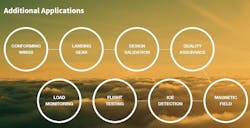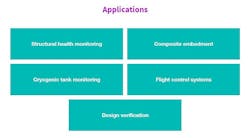Sensuron spins out of 4DSP, debuts compact fiber optic sensing
AUSTIN, Texas, 25 Aug. 2015. Sensuron, a global provider of compact fiber-optic sensing (FOS) systems in Austin, Texas, spun off from sister company 4DSP to form an entity aimed at solving problems on a global scale and enabling innovation using light-based technologies that ensure aerospace equipment is functional, reliable, and safe. The company also is introducing its RTS 125 and RTS 150 systems.
“By investing in compact FOS solutions, businesses can consolidate several disparate technologies into a single platform to continuously test, control, and monitor the health of systems to ensure success long into the future. Sensuron’s FOS platform enables innovations that change industries,” explains Michael Heflin, CEO Sensuron.
Sensuron provides fiber optic sensing (FOS) solutions to brands like NASA, SpaceX, and Virgin Galactic. NASA uses the company’s FOS products to detect wing deformation in flight to improve safety, reduce maintenance, and enhance in-flight efficiency of aircraft -- all which result in reduced costs.
Sensuron’s RTS125 and RTS150 FOS platforms are smaller, lighter and faster than industry alternatives and allow for unprecedented levels of performance and monitoring for aerospace applications. The platform uses light to measure minuscule changes in temperate, liquid level and stress parameters to determine the efficiency and long-term durability of materials. For more information, check out: http://www.sensuron.com/solutions/aerospace/.
“We have been collaborating with 4DSP, now Sensuron, to develop the next generation of fiber optic sensing systems for the last 10 years,” says Allen Parker, engineer, NASA Armstrong Flight Research Center. “Based on the concerted and cooperative effort, we’ve been able to build an exponentially smaller compact system compared to what was previously used on the market, with exceptional accuracy that enhances testing, designing, measuring, monitoring, and operating applications across industries. Driven by NASA’s ultra-efficient algorithms, this compact FOS system represents a major breakthrough in high-speed operational monitoring and sensing technology.”
Across aerospace, equipment deterioration and the continuous monitoring of materials can be expensive to maintain and costly to an organization’s operations. Defective equipment can pose risks for civilians and consumers. For example, without careful monitoring, strain during flight can lead to airplane structural heath issues. Additionally in launch vehicles, liquid level in fuel tanks may be higher than needed reducing payload capacity. In the energy field, unreported collisions with rigs can cause long-term structural risks.
Using existing techniques for monitoring equipment, engineers are struggling to keep up with industry developments. However, solutions that not only solve problems, but also help engineers to approach challenges with new thinking, will increase competitive advantages.
Sensuron’s compact FOS technology uses light to measure miniscule changes in temperature, volume, liquids and stress over a variety of surface areas. In addition, the platform can provide 2D and 3D shape sensing. By monitoring the changes in a network of hair-thin fibers, Sensuron’s solution can ensure the integrity, efficiency, location, and long-term durability of equipment across the demanding aerospace, medical and energy industries.The fiber sensors reflect light readings back to a hardware system, which converts optical data into analog and then digital signals. This provides users with real-time measurements.
The FOS industry is growing with the global consumption value of fiber optic point sensors and continuous distributed fiber optics sensor systems expected to increase to $2.2 billion by 2018, up from $1.8 billion in 2013.
Beyond aerospace, medical, and energy applications, Sensuron’s compact FOS technology has the ability to:
- Increase public safety: Sensuron’s technology monitors the structural health of aircrafts, buildings, nuclear equipment, dams, automobiles, trains, etc.
- Save resources: Sensuron’s FOS solutions improve the efficiency of wind turbines
- Detect structural instabilities: Sensuron’s RTS125 and RTS150 systems monitor components and structures within tunnels, chemicals, or nuclear power plants
- Enhance breakthroughs: Sensuron’s technology improves the precision of medical instruments and industrial tools so surgeons can operate in new and safer ways
- Improve accuracy: Sensuron’s compact FOS systems precisely measure liquid levels in vats of chemicals, cryogenic liquids, fuel, water, oil, etc.
FOS technologies collect and analyze material and structural data based on changes in the way light moves down a fiber optic cable. FOS technologies extract environmental parameters such as strain loads, temperature gradients, as well as 2D and 3D shape sensing when light is passed through a network of hair-thin fibers. By measuring the changes in how light reflects back given various changes in these parameters, FOS technology can provide real-time monitoring of applications, helping to ensure the integrity, efficiency, and long-term durability of equipment.
Sensuron is a global provider of fiber-optic sensing systems that use light to test, measure, and control applications across the aerospace, medical and energy industries. With seven years of experience working closely with NASA, Sensuron has a rich heritage in groundbreaking innovation and customer success. Sensuron’s mission is to solve problems on a global scale by utilizing light-based technologies that ensure equipment is functional, reliable and safe. The company strives not only to provide the most sophisticated sensing platforms on the market, but also to serve today’s engineers by providing the information they require to advance their innovations. In these ways and many others, Sensuron continues to help customers achieve their objectives today and will do so for years to come.


